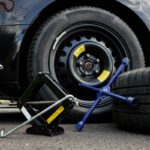An ominous brown stain is found on the fender. There is a paint bubble at the bottom of a door. The floors got soaked after they fell into the puddle. Rust indicates that the ironworm has been busy. Rust can be found in all cars, even in Dubai. It affects every car driver. It is a terrible thing. It is best to run from it. Rust will eventually arrive. We can help you if your car is damaged by rust in Dubai.
Because iron is a fragile chemical element, it will rust in natural environments regardless of the complicated coatings and alloys created by engineers and chemists. Iron and most steel will eventually decompose completely if given enough time. However, this does not mean that your car cannot be driven in Dubai anymore. Knowing how cars rust and where to look for problems can help you enjoy your car as much as possible. You can take your car to a garage for repairs if the situation gets worse.
What causes your car to rust?
When iron-based metals are electrochemically broken down, rust is formed. This is caused by the process of oxidation in which iron surface molecules react with oxygen in order to create a new molecule. Also known as iron oxide, this happens. Iron oxide is the main component of rust.
Exposed steel rusts at different rates depending on the alloy, its thickness, climate, and the heat treatment it is subject to. There’s also the salt effect. Electrolytes can be impurities like road salts or other pollutants that are dissolved in water. The chemical reaction in which electrolytes are used accelerates the exchange of molecular components.
Alloying elements like nickel and chromium added to automobile steel can help prevent rust, but nothing is fool-proof–everything corrodes eventually. The sheet steel of today has extremely durable coatings once it is removed from the roll. These coatings are further enhanced at final assembly plants where newly built vehicles are treated with anti-corrosion chemicals before being painted.
Different types of Rust
- Surface Rust
Surface rust is caused by paint that has been damaged by UV or mechanical damage. This can happen even in dry, hot conditions. Surface rust does not pose a structural problem. Depending on the thickness and alloy composition of the metal, there is a degree of “passivation” where the metal is protected from further oxidation.
- Scale Rust
If you don’t treat surface rust and let the decomposition progress further into the metal, bubbles may form in the paint of your car. Iron oxide molecules are more powerful than steel or iron molecules. Scale is caused by rust piercing the surface. Scale can be removed using a wire brush, a grinder wheel to remove the roughness and sandpaper.
- Penetrating Rust
Scale is caused by rust leaking into the surface. Scale can be removed using a wire brush, a grinder wheel to remove any roughness and sandpaper. You should not attempt to reassemble the car’s frame.
How can rust be stopped?
To prevent corrosion, it is a good idea to wash your car on a regular basis. Modern car washes can blast dirt from underneath your vehicle with water. The bottoms of doors, rocker panels and rocker panels have drain holes that allow rainwater to escape. Use a pipe cleaner to clean the holes and dry the car’s crevices. WD-40 is also an option. This lubricant can be used to blast away water and corrosive dirt from underbody areas. It also protects against corrosion.
You can remove any rust from the surface. Next, sand the area with sandpaper. Spray or brush the new coating as you would with other rust restorations. Even the most severely damaged winter beater should still be safe to drive for many years.


